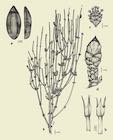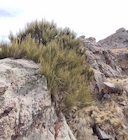Ephedra americana
Humb. et Bonpl. ex Willd. 1806
Common names
Jointfir, pinco-pinco.
Taxonomic notes
Syn.: Ephedra peruviana Bertero ex Carr. 1855; Ephedra americana Humb. & Bonpl. ex Willd. var. humboldtii Stapf 1889.
Description
Dioecious shrubs, or trees up to 3.5 m tall, or creeping subshrubs. Twigs opposite or whorled, erect to semi-pendulous. Persistent, recurved leaves in decussate whorls, forming a basal sheath, with reduced membranous wings at the base of the free tips. Pollen cones sessile, decussate or rarely in whorls of 3. Seed cones ellipsoid, decussate or rarely in whorls of 3, bracts fused for 2/3 to 3/4 of their length, fleshy when mature. Seeds 2 (Martínez Carretero 2018). Note that Martínez Carretero (2018) treats Ephedra breana as synonymous with E. americana, thus the description given here does not serve to distinguish the two taxa.
Martínez Carretero (2018) also gives a key to the six Argentine species of Ephedra.
Distribution and Ecology
Argentina: Catamarca, Córdoba; Bolivia; Chile: Atacama, Antofagasta, Tarapacá; Ecuador; Peru. Found at 1500-4100 m elevation, in shrubby grassland, scrub, or semi-desert; often associated with cacti on dry rocky slopes and hills or on sandy/clayey soils. Locally abundant, not threatened, and found in some protected areas, it is not a species of conservation concern (Bell and Bachman 2011).
Remarkable Specimens
No data as of 2023.03.03.
Ethnobotany
Observations
Remarks
The epithet means "American" (South American, of course).
Citations
Bell, A. and S. Bachman. 2011. Ephedra americana. The IUCN Red List of Threatened Species 2011. https://www.iucnredlist.org/species/201709/9170748, accessed 2021.12.27.
Martínez Carretero, Eduardo. 2018. Ephedraceae Dumort. in Flora de Mendoza, Multequina 27: Fascículo 10, FM 1-9. Available: https://www.redalyc.org/jatsRepo/428/42857911008/42857911008.pdf, accessed 2021.12.26.
Willdenow, K. L. 1806. Species Plantarum., ed. 4, Vol. 4, Part 2, p. 860. Available: Biodiversity Heritage Library, accessed 2021.12.23.
See also
Species profile at Plants of the World Online, accessed 2021.12.27.




